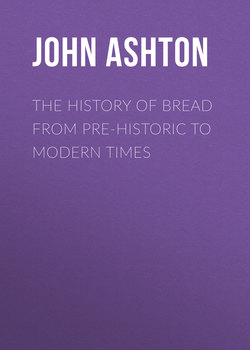The History of Bread From Pre-historic to Modern Times

Реклама. ООО «ЛитРес», ИНН: 7719571260.
Оглавление
Ashton John. The History of Bread From Pre-historic to Modern Times
PREFACE
CHAPTER I. PRE-HISTORIC BREAD
CHAPTER II. CORN IN EGYPT AND ASSYRIA
CHAPTER III. BREAD IN PALESTINE
CHAPTER IV. THE BREAD OF THE CLASSIC LANDS
CHAPTER V. BREAD IN EASTERN LANDS
CHAPTER VI. BREAD IN EUROPE AND AMERICA
CHAPTER VII. Early English Bread
CHAPTER VIII. HOW GRAIN BECOMES FLOUR
CHAPTER IX. THE MILLER AND HIS TOLLS
CHAPTER X. BREAD MAKING AND BAKING
CHAPTER XI. OVENS ANCIENT AND MODERN
CHAPTER XII. THE RELIGIOUS USE OF BREAD
CHAPTER XIII. GINGER BREAD AND CHARITY BREAD
CHAPTER XIV. BREAD RIOTS
CHAPTER XV. LEGENDS ABOUT BREAD
Отрывок из книги
Man, as is evidenced by his teeth, was created graminivorous, as well as carnivorous, and the earliest skull yet found possesses teeth exactly the same as modern man, the carnivorous teeth not being bigger, whilst in many cases the whole of the teeth have been worn down, as if by masticating hard substances, such as parched grain.
In the history of bread, the lake dwellings of Switzerland are most useful, as from them we can gather the cereals their inhabitants used, their bread, and the implements with which they crushed the corn. The men who lived in them are the earliest known civilised inhabitants of Europe – by which I mean that they cultivated several kinds of cereals – wove cloth, made mats, baskets, and fishing nets, and, besides, baked bread.
.....
Special favour was accorded to Ruth. She might glean ‘among the sheaves’ —i. e., following the reapers, instead of waiting until the corn had been carried; but the Jews were enjoined to be liberal in the matter of gleaning, as we see by Lev. xix. 9: ‘And when ye reap the harvest of your land, thou shalt not wholly reap the corners of thy field, neither shalt thou gather the gleanings of thy harvest’; and in Deut. xxiv. 19, ‘When thou cuttest down thine harvest in thy field, and hast forgot a sheaf in the field, thou shalt not go again to fetch it; it shall be for the stranger, for the fatherless, and for the widow: that the Lord thy God may bless thee in all the work of thine hands.’
There were no public mills at which flour could be ground, but, as now, in the unchangeable East, every family ground their own corn, and this task, as well as the making and baking of bread, was left to the women. See Matt. xxiv. 41: ‘Two women shall be grinding at the mill; the one shall be taken, and the other left.’ Again we find that it was a woman who was grinding corn on a housetop in Thebez who (Judges ix. 53) ‘cast a piece of a millstone upon Abimelech’s head, and all to brake his skull.’ An Eastern flour mill consists of two stones, the upper one rotating on the lower. In Shaw’s Travels, p. 297, he says: ‘Most families grind their wheat and barley at home, having two portable millstones for that purpose. The uppermost is turned round by a small handle of wood or iron placed in the edge of it. When this stone is large, or expedition is required, then a second person is called in to assist. It is usual for the women alone to be concerned in this employ, setting themselves down over against each other, with the millstones between them.’
.....